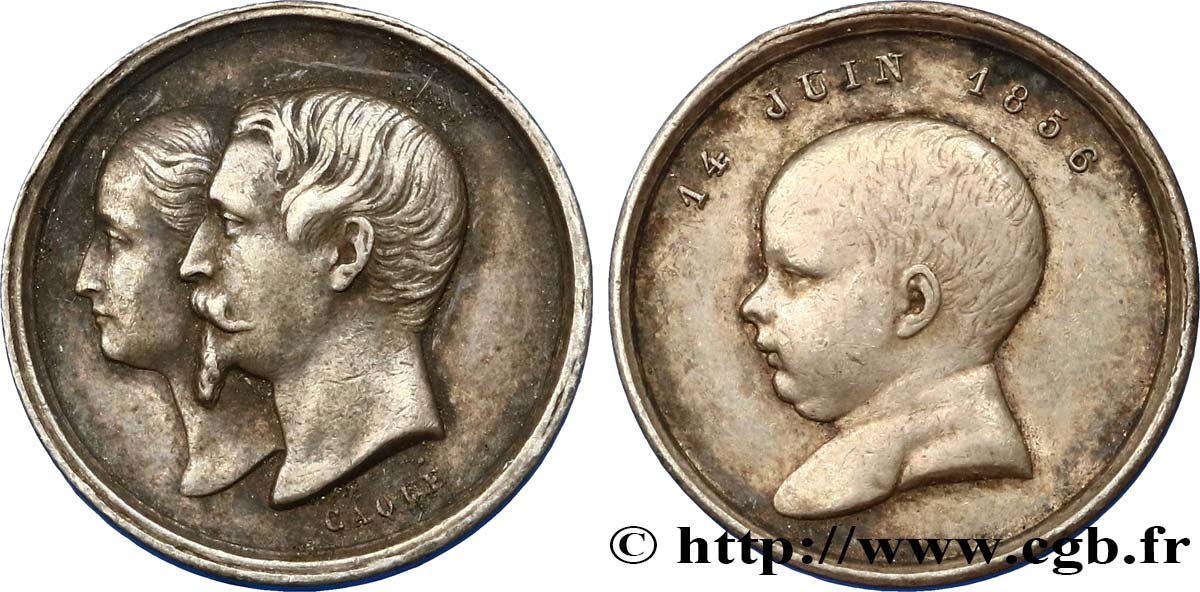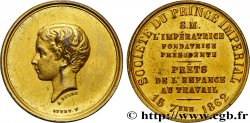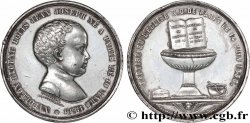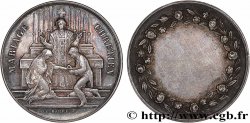E-auction 225-149674 - fjt_417900 - NAPOLÉON IV Naissance - quinaire 1856
Devi Sign-in ed essere un offerente approvato fare un'offerta, Login per fare offerte. Conti sono soggetti ad approvazione e di approvazione sono raggiunti entro 48 ore. Non aspettare fino al giorno di una vendita si chiude per registrarti.Confermando la tua offerta su questo oggetto ti impegni ad un contratto legalmente vincolante per l'acquisto di questo prodotto e fare clic su «offerta» costituisce accettazione dei termini di utilizzo de e-auctions cgb.fr.
Offerta deve essere collocato in euro gli importi interi vendita only.The si chiuderà al momento sulla descrizione dell'oggetto, eventuali offerte pervenute al sito dopo l'orario di chiusura non verranno eseguite. Volte transmition possono variare e le offerte potrebbero essere respinto se si attende per gli ultimi secondi. Per ulteriori informazioni ckeck le FAQ.
SENZA COSTI PER GLI ACQUIRENTI.
SENZA COSTI PER GLI ACQUIRENTI.
| Valutazione : | 15 € |
| Prezzo : | 4 € |
| Offerta maxima : | 11 € |
| Data di fine vendita : | 07 agosto 2017 18:41:30 |
| partecipanti : | 3 partecipanti |
Tipo : Naissance - quinaire
Data: 1856
Metallo : argento
Diametro : 15 mm
Asse di coniazione : 12 h.
Peso : 1,93 g.
Orlo : lisse
Marchio : Main
Diritto
Descrittivo diritto : Bustes en jugate de l'empereur Napoléon III et de son épouse l'impératrice Eugénie.
Rovescio
Titolatura rovescio : 14 JUIN 1856.
Descrittivo rovescio : Buste de leur fils, futur Napoléon IV.
Commento
Le poinçon de ce jeton est une main indicatrice mais sans le mot ARGENT, ce qui s’explique probablement par la taille du jeton.
Ce jeton a certainement été frappé pour commémorer le baptême de leur fils Napoléon IV et distribué à la foule lors des réjouissances.
Wikipedia nous informe de la cérémonie :
L'arrivée au monde de cet héritier fut pénible pour l'impératrice Eugénie qui a beaucoup souffert en lui donnant la vie. Il fallut recourir aux fers dont l'enfant porta au front les traces. Pour la naissance du prince, la ville de Paris lui offrit un berceau aux armes de l'Empire (ce berceau est toujours visible au musée Carnavalet à Paris).
Le 14 juin 1856, le prince impérial fut baptisé en grande pompe à Notre-Dame de Paris. Napoléon III dit de la cérémonie et des réjouissances qui s'en suivirent : « Un tel baptème vaut bien un sacre.» La famille impériale fut conduite dans le carrosse qui servit à Reims, lors du sacre de Charles X. Le parrain est le pape Pie IX et la marraine est la reine Victoria d'Angleterre. Cependant, celle-ci étant de religion anglicane, c'est la reine de Suède, Joséphine, fille d'Eugène de Beauharnais, cousine de l'empereur, qui la représente. Le pape se fit représenter par le cardinal-légat Patrizzi, qui baptisa l'enfant.
Dans l'acte officiel, conservé sur le registre des baptêmes de l'église Saint-Germain-l'Auxerrois, dont dépendait la chapelle des Tuileries, il fut déclaré "fils de France", titre que Napoléon Ier avait utilisé pour son fils, le roi de Rome, et repris de l'Ancien régime. Il fut question de lui donner un titre royal, celui de Roi d'Alger, mais cette idée fut abandonnée.
La suite à http://fr.wikipedia.org/wiki/Louis_Napol%C3%A9on_Bonaparte_%28Prince_imp%C3%A9rial%29.
The hallmark of this token is an indicator hand but without the word SILVER, which is probably explained by the size of the token.
This token was certainly struck to commemorate the baptism of their son Napoleon IV and distributed to the crowd during the celebrations..
Wikipedia tells us about the ceremony: The arrival of this heir was painful for Empress Eugenie, who suffered greatly in giving birth to him.. It was necessary to resort to irons, the marks of which were left on the child's forehead.. For the birth of the prince, the city of Paris offered him a cradle bearing the coat of arms of the Empire (this cradle can still be seen at the Carnavalet Museum in Paris).
On June 14, 1856, the Prince Imperial was baptized with great pomp at Notre-Dame de Paris.. Napoleon III said of the ceremony and the festivities that followed: \\\"Such a baptism is well worth a coronation.\\\". \\\"The imperial family was driven in the carriage that was used in Reims during the coronation of Charles X. The godfather is Pope Pius IX and the godmother is Queen Victoria of England. However, since she was of the Anglican religion, it was the Queen of Sweden, Josephine, daughter of Eugène de Beauharnais, cousin of the Emperor, who represented her.. The Pope was represented by Cardinal Legate Patrizzi, who baptized the child.
In the official document, preserved in the baptismal register of the church of Saint-Germain-l'Auxerrois, on which the chapel of the Tuileries depended, he was declared \\\"son of France\\\", a title that Napoleon I had used for his son, the King of Rome, and taken from the Ancien Régime. There was talk of giving him a royal title, that of King of Algiers, but this idea was abandoned..
Continued at http://fr. Wikipedia. org/wiki/Louis_Napol%C3%A9on_Bonaparte_%28Prince_imp%C3%A9rial%29
Ce jeton a certainement été frappé pour commémorer le baptême de leur fils Napoléon IV et distribué à la foule lors des réjouissances.
Wikipedia nous informe de la cérémonie :
L'arrivée au monde de cet héritier fut pénible pour l'impératrice Eugénie qui a beaucoup souffert en lui donnant la vie. Il fallut recourir aux fers dont l'enfant porta au front les traces. Pour la naissance du prince, la ville de Paris lui offrit un berceau aux armes de l'Empire (ce berceau est toujours visible au musée Carnavalet à Paris).
Le 14 juin 1856, le prince impérial fut baptisé en grande pompe à Notre-Dame de Paris. Napoléon III dit de la cérémonie et des réjouissances qui s'en suivirent : « Un tel baptème vaut bien un sacre.» La famille impériale fut conduite dans le carrosse qui servit à Reims, lors du sacre de Charles X. Le parrain est le pape Pie IX et la marraine est la reine Victoria d'Angleterre. Cependant, celle-ci étant de religion anglicane, c'est la reine de Suède, Joséphine, fille d'Eugène de Beauharnais, cousine de l'empereur, qui la représente. Le pape se fit représenter par le cardinal-légat Patrizzi, qui baptisa l'enfant.
Dans l'acte officiel, conservé sur le registre des baptêmes de l'église Saint-Germain-l'Auxerrois, dont dépendait la chapelle des Tuileries, il fut déclaré "fils de France", titre que Napoléon Ier avait utilisé pour son fils, le roi de Rome, et repris de l'Ancien régime. Il fut question de lui donner un titre royal, celui de Roi d'Alger, mais cette idée fut abandonnée.
La suite à http://fr.wikipedia.org/wiki/Louis_Napol%C3%A9on_Bonaparte_%28Prince_imp%C3%A9rial%29.
The hallmark of this token is an indicator hand but without the word SILVER, which is probably explained by the size of the token.
This token was certainly struck to commemorate the baptism of their son Napoleon IV and distributed to the crowd during the celebrations..
Wikipedia tells us about the ceremony: The arrival of this heir was painful for Empress Eugenie, who suffered greatly in giving birth to him.. It was necessary to resort to irons, the marks of which were left on the child's forehead.. For the birth of the prince, the city of Paris offered him a cradle bearing the coat of arms of the Empire (this cradle can still be seen at the Carnavalet Museum in Paris).
On June 14, 1856, the Prince Imperial was baptized with great pomp at Notre-Dame de Paris.. Napoleon III said of the ceremony and the festivities that followed: \\\"Such a baptism is well worth a coronation.\\\". \\\"The imperial family was driven in the carriage that was used in Reims during the coronation of Charles X. The godfather is Pope Pius IX and the godmother is Queen Victoria of England. However, since she was of the Anglican religion, it was the Queen of Sweden, Josephine, daughter of Eugène de Beauharnais, cousin of the Emperor, who represented her.. The Pope was represented by Cardinal Legate Patrizzi, who baptized the child.
In the official document, preserved in the baptismal register of the church of Saint-Germain-l'Auxerrois, on which the chapel of the Tuileries depended, he was declared \\\"son of France\\\", a title that Napoleon I had used for his son, the King of Rome, and taken from the Ancien Régime. There was talk of giving him a royal title, that of King of Algiers, but this idea was abandoned..
Continued at http://fr. Wikipedia. org/wiki/Louis_Napol%C3%A9on_Bonaparte_%28Prince_imp%C3%A9rial%29








 Segnalare un errore
Segnalare un errore Stampate la pagina
Stampate la pagina Condividi mia selezione
Condividi mia selezione Fai una domanda
Fai una domanda Consegnare / vendere
Consegnare / vendere
 Descrittivo
Descrittivo












